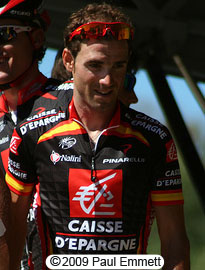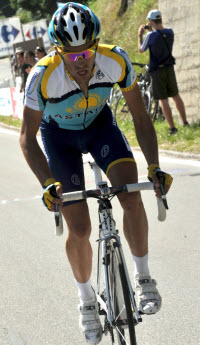 Spain’s four leading Grand Tour riders were all present at today’s presentation of the 2010 Vuelta a España route, and all hailed it as a route to suit climbers. After the stage 1 nocturnal time trial in Sevilla, the course traverses the south coast, calling at the resort town of Marbella on it’s way to the first major challenges in the south-eastern region of Murcia.
Spain’s four leading Grand Tour riders were all present at today’s presentation of the 2010 Vuelta a España route, and all hailed it as a route to suit climbers. After the stage 1 nocturnal time trial in Sevilla, the course traverses the south coast, calling at the resort town of Marbella on it’s way to the first major challenges in the south-eastern region of Murcia.
The first long transfer take the course to the north-eastern region of Calalunia and a tough stage up to the ski resort of Vallnord in Andorra, before heading west for more climbing stages in the Pyrénées. A 46km time trial will be followed by some transition stages, but before the final processional stage into Madrid, there will be a sting in the tail as the race climbs to the 2250m Bola del Mundo.
“I sincerely believe that the 2010 Vuelta route clearly benefits climbers, as do the Giro and the Tour routes this year” said Carlos Sastre.
He sees some consolation for non-climbers, but acknowledges that the course is tailor made for the mountain men. “There are two time trial stages, one is a team trial in Seville at the start and then there is quite a long, individual trial in Peñafiel towards the end of the Vuelta," said the winner of the 2007 Tour de France.
"That is compensated for though by the seven [six, actually - ed] mountain finishes and other rather difficult stages, such as the one and a half kilometre climb at the finish of the third stage, and the stage that finishes in Murcia, with a climb up to the Cresta del Gallo in the final kilometres”
The 2010 Vuelta, says Sastre, will be “a spectacular route, with new, explosive and unprecedented climbs, such as the Xorret del Catí, the Lakes of Covadonga and a series of passes that I’m not familiar with, like Peña Cabarga in Cantabria and Coto Bello in Asturias”.
“Of course it will be necessary to analyze the stages one by one but at first sight it looks like a very nice one," said 2009 winner Alejandro Valverde, "very hard and for sure rich in emotions from the very beginning till the end since the first stage, a team time trial, is already a difficult challenge. Famous mountains and individual time trials make also part of the program. Moreover two stages will take place where I live, in Murcia, what will for sure represent an extra motivation for me.”
Whether or not Valverde returns to defend his title next August is undecided though. “The season is very long and it will depend and it is too early to be sure," he said. "It will depend on how things go but of course I hope I will be there."
“It’s a nice course, in addition to many mountaintop finishes I think it will be very interesting for spectators,” Tour de France champion Alberto Contador said in esciclismo.com. “One must be vigilant from the beginning. The first week has a lot of ‘puertecitos’ [small climbs], which at first glance shouldn’t create too many gaps, but can be punishing.”
“Once the race gets to Asturias,” he continued, “the three consecutive mountain stages and the time trial the next day will greatly influence the recovery of all the riders”
 “It will be spectacular,” said Contador, “there is little respite and you can’t relax for a moment, because the gaps could be crucial at the end of the race. It’s true that on the terrain it’s possible to recover a little time, but it’s better not to waste anything.”
“It will be spectacular,” said Contador, “there is little respite and you can’t relax for a moment, because the gaps could be crucial at the end of the race. It’s true that on the terrain it’s possible to recover a little time, but it’s better not to waste anything.”
Olympic champion Samuel Sanchez was excited by the mountainous route, and some climbs in particular: “Cotobello [stage 16 – ed] is a stage that has very difficult mountains,” he told esciclismo.com, “with some gradients of 10 or 11 percent in the case of San Lorenzo. The Cobertoria I think is long at about 9 percent, and to top it off has 10km of 8.5 percent. It’s a real Tour stage.”
He also found the position of the second rest day to be very significant. “People can relax,” he said, “but there is a 46km time trial the next day in which there will be a lot of time gaps. The Vuelta will be decided after it leaves Peñafiel.”
“From the beginning one must be attentive, whoever wants to earn victory must earn it from Sevilla to Madrid.”
The nocturnal team time trial in Sevilla he sees as a positive and novel idea. “Everyone loves to innovate in sport,” he said. “It will be a real hit to do this in a city like Sevilla at night.”
The 2010 course passes close to the Olympic champion’s home Basque region, somewhere it has not visited for many years due to the threat of terrorism from local separatist group ETA. Organisers have hinted that the race may return to the region in the near future, something Sanchez would relish.
“I always answer this the same,” he said, “I see it as a good option because the Basque Country probably has the best fans in Spain. The great sports fans, and cycling, deserves to see a stage there because the Basque territory is fantastic and challenging courses can be made… It would be very nice.”